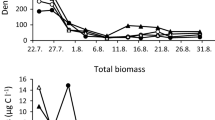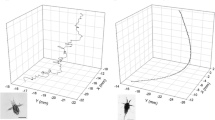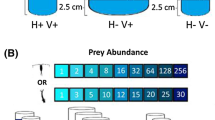Abstract
Turbulence can affect predator–prey interactions. The effect of turbulence on the feeding efficiency of an ambush predator was tested with laboratory experiments. The experiments were conducted in 100-L aquaria in which ten individuals of fourth instar Chaoborus flavicans larvae were placed as predators. Two prey densities (3 and 10 ind. of Daphnia pulex L−1) and two durations (30 and 120 min) were tested in a nonturbulent treatment and five different turbulence levels [average root-mean-square (RMS) velocities ranging from 0 to 7.3 cm s−1, corresponding dissipation rates from 7.2 × 10−7 to 1.3 × 10−3 m2 s−3]. We hypothesized that the feeding rate of C. flavicans would be enhanced by turbulence due to increasing encounter rates up to a turbulence level above which a disturbance in post-encounter processes would lead to reduced feeding efficiency. However, the results showed no significant increase in the feeding rate of C. flavicans at intermediate turbulence. At high turbulence we found the expected significant negative response in the feeding rate of Chaoborus larvae. The feeding rate declined below the rates at nonturbulent and intermediate turbulence conditions as the average RMS velocity exceeded 3.1 cm s−1 (dissipation rate 9.9 × 10−5 m2 s−3, respectively).




Similar content being viewed by others
References
Allan, J. D., 1973. Competition and the relative abundances of two cladocerans. Ecology 54: 484–498.
Baranyai, E., L. G.-Tóth, A. Vári & Z. G. Homonnay, 2011. The effect of variable turbulent intensities on the distribution of zooplankton in the shallow, large Lake Balaton (Hungary). Knowledge and Management of Aquatic Ecosystems 400: 1–13.
Brooks, J. L. & S. I. Dodson, 1965. Predation, body size and composition of the plankton. Science 150: 28–35.
Cuker, B. E., 1993. Suspended clays alter trophic interactions in the plankton. Ecology 74: 944–953.
Dodson, S. I., 1974. Zooplankton competition and predation: an experimental test of the size-efficiency hypothesis. Ecology 55: 605–613.
Etemad-Shahidi, A. & J. Imberger, 2001. Anatomy of turbulence in thermally stratified lakes. Limnology and Oceanography 46: 1158–1170.
Fedorenko, A. Y. 1973. Predation interactions between zooplankton and two species of Chaoborus (Diptera, Chaoboridae) in a small coastal lake. MSc Thesis. University of British Columbia: 123 pp.
Giguère, L. A., 1986. The estimation of crop evacuation rates in Chaoborus larvae (Diptera: Chaoboridae) using natural prey. Freshwater Biology 16: 557–560.
G.-Tóth, L., L. Parpala, C. Balogh, I. Tátrai & E. Baranyai, 2011. Zooplankton community response to enhanced turbulence generated by water-level decrease in Lake Balaton, the largest shallow lake in Central Europe. Limnology and Oceanography 56: 2211–2222.
Holling, C. S., 1959. The components of predation as revealed by a study of small mammal predation of the European pine sawly. Canadian Entomologist 91: 293–320.
Hongve, D., 1975. On the ecology and distribution of Chaoborus (Chaoboridae, Diptera) from the Upper Romerike District, south-east Norway. Norwegian Journal of Entomology 22: 49–57.
Horppila, J. & A. Liljendahl-Nurminen, 2005. Clay-turbid interactions may not cascade – a reminder for lake managers. Restoration Ecology 13: 241–245.
Horridge, G. A., 1966. Some recently discovered underwater vibration receptors in invertebrates. In Barnes, H. (ed.), Some Contemporary Studies in Marine Science. Allen and Undwin, London: 395–405.
Humphries, D. A. & P. M. Driver, 1970. Protean defence by prey animals. Oecologia 5: 285–302.
Jeschke, J. M. & R. Tollrian, 2007. Prey swarming: which predators become confused and why? Animal Behaviour 74: 387–393.
Joensuu, L., Z. Pekcan-Hekim, N. Hellén & J. Horppila 2013. Turbulence disturbs vertical refuge use by Chaoborus flavicans larvae and increases their horizontal dispersion. Freshwater Biology. doi:10.1111/fwb.12186.
Kankaala, P. & P. Eloranta, 1987. Epizooic ciliates (Vorticella sp.) compete for food with their host Daphnia longispina in a small polyhumic lake. Oecologia 73: 203–206.
Kiørboe, T. & E. Saiz, 1995. Planktivorous feeding in calm and turbulent environments, with emphasis on copepodes. Marine Ecology-Progress Series 122: 135–145.
Kundu, P. K. & I. M. Cohen, 2010. Fluid Mechanics. Academic Press, San Diego.
Liljendahl-Nurminen, A., J. Horppila, T. Malinen, P. Eloranta, M. Vinni, E. Alajärvi & S. Valtonen, 2003. The supremacy of invertebrate predators over fish – factors behind the unconventional seasonal dynamics of cladocerans in Lake Hiidenvesi. Archiv für Hydrobiologie 158: 75–96.
Lough, R. G. & D. G. Mountain, 1996. Effect of small-scale turbulence on feeding rates of larval cod and haddock in stratified water on Georges Bank. Deep-Sea Research II 43: 1745–1772.
Luokkanen, E. 1994. Vesikirppuyhteisön lajisto, biomassa ja tuotanto Vesijärven Enonselällä. MSc Thesis, University of Helsinki: 58 pp (in Finnish).
MacKenzie, B. R. & T. Kiørboe, 2000. Larval fish feeding and turbulence: a case for the downside. Limnology and Oceanography 45: 1–10.
MacKenzie, B. R. & W. C. Leggett, 1991. Quantifying the contribution of small-scale turbulence to the encounter rates between larval fish and their zooplankton prey: effects of wind and tide. Marine Ecology – Progress Series 73: 149–160.
MacKenzie, B. R., T. J. Miller, S. Cyr & W. C. Leggett, 1994. Evidence for a dome-shaped relationship between turbulence and larval fish ingestion rates. Limnology and Oceanography 39: 1790–1799.
Marrasé, C., J. H. Costello, T. Granata & J. R. Strickler, 1990. Grazing in a turbulent environment: energy dissipation, encounter rates, and efficacy of feeding currents in Centropages hamatus. Proceedings of the National Academy of Sciences of the United States of America 87: 1653–1657.
Moum, J. N., 1996. Energy-containing scales of turbulence in the ocean thermocline. Journal of Geophysical Research 101: 14095–14109.
Osborn, T., 1996. The role of turbulent diffusion for copepods with feeding currents. Journal of Plankton Research 18: 185–195.
Pastorok, R. A., 1980. The effects of predator hunger and food abundance on prey selection by Chaoborus larvae. Limnology and Oceanography 25: 910–921.
Pastorok, R. A., 1981. Prey vulnerability and size selection by Chaoborus larvae. Ecology 62: 1311–1324.
Peters, F. & J. M. Redondo, 1997. Turbulence generation and measurement: application to studies on plankton. Scientia Marina 61: 205–228.
Riessen, H. P., W. J. O’Brien & B. Loveless, 1984. An analysis of the components of Chaoborus predation on zooplankton and the calculation of relative prey vulnerabilities. Ecology 65: 514–522.
Rothschild, B. J. & T. R. Osborn, 1988. Small-scale turbulence and plankton contact rates. Journal of Plankton Research 10: 465–474.
Saggio, A. & J. Imberger, 2001. Mixing and turbulent fluxes in the metalimnion of a stratified lake. Limnology and Oceanography 46: 392–409.
Saiz, E. & T. Kiørboe, 1995. Predatory and suspension-feeding of the copepod Acartia tonsa in turbulent environments. Marine Ecology – Progress Series 122: 280–289.
Saiz, E., M. Alcaraz & G.-A. Paffenhöfer, 1992. Effects of small-scale turbulence on feeding rate and gross-growth efficiency of three Acartia species (Copepoda: Calanoida). Journal of Plankton Research 14: 1085–1097.
Smyly, W. J. P., 1980. Food and feeding of aquatic larvae of the midge Chaoborus flavicans (Meigen) (Diptera: Chaoboridae) in the laboratory. Hydrobiologia 70: 179–188.
Stiansen, J. E. & S. Sundby, 2001. Improved methods for generating and estimating turbulence in tanks suitable for fish larvae experiments. Scientia Marina 65: 151–167.
Sundby, S. & P. Fossum, 1990. Feeding conditions of Arcto-norwegian cod larvae compared with the Rothschild–Osborn theory on small-scale turbulence and plankton contact rates. Journal of Plankton Research 12: 1153–1162.
Swift, M. C. & A. Y. Fedorenko, 1973. A rapid method for the analysis of the crop contents of Chaoborus larvae. Limnology and Oceanography 18: 795–798.
Swift, M. C. & A. Y. Fedorenko, 1975. Some aspects of prey capture by Chaoborus larvae. Limnology and Oceanography 20: 418–425.
Unger, P. A. & W. M. Lewis Jr, 1983. Selective predation with respect to body size in a population of the fish Xenomelaniris venezuelae (Atherinidae). Ecology 64(5): 1136–1144.
von Ende, C. N., 1979. Fish predation, interspecific predation, and the distribution of two Chaoborus species. Ecology 60: 119–128.
Wagner-Döbler, I., 1988. Vertical migration of Chaoborus flavicans (Diptera, Chaoboridae): the control of day and night depth by environmental parameters. Archiv für Hydrobiologie 114: 251–274.
Yen, J. & J. R. Strickler, 1996. Advertisement and concealment in the plankton: what makes a copepod hydrodynamically conspicuous? Invertebrate Biology 115: 191–205.
Young, S., P. J. Watt, J. P. Grover & D. Thomas, 1994. The unselfish swarm? Journal of Animal Ecology 63: 611–618.
Zaret, T. M., 1980. Predation and Freshwater Communities. Yale University Press, New Haven.
Acknowledgments
The study was financed by the Academy of Finland (project 131579). Jouko Sarén assisted with the construction of the experimental setup and Saija Rautakorpi helped with the data collection. We acknowledge William M. Lewis, Jr., and the anonymous reviewer for the valuable comments improving the manuscript.
Author information
Authors and Affiliations
Corresponding author
Additional information
Handling editor: Karl E. Havens
Rights and permissions
About this article
Cite this article
Härkönen, L., Pekcan-Hekim, Z., Hellén, N. et al. Feeding efficiency of Chaoborus flavicans (Insecta, Diptera) under turbulent conditions. Hydrobiologia 722, 9–17 (2014). https://doi.org/10.1007/s10750-013-1670-y
Received:
Revised:
Accepted:
Published:
Issue Date:
DOI: https://doi.org/10.1007/s10750-013-1670-y




